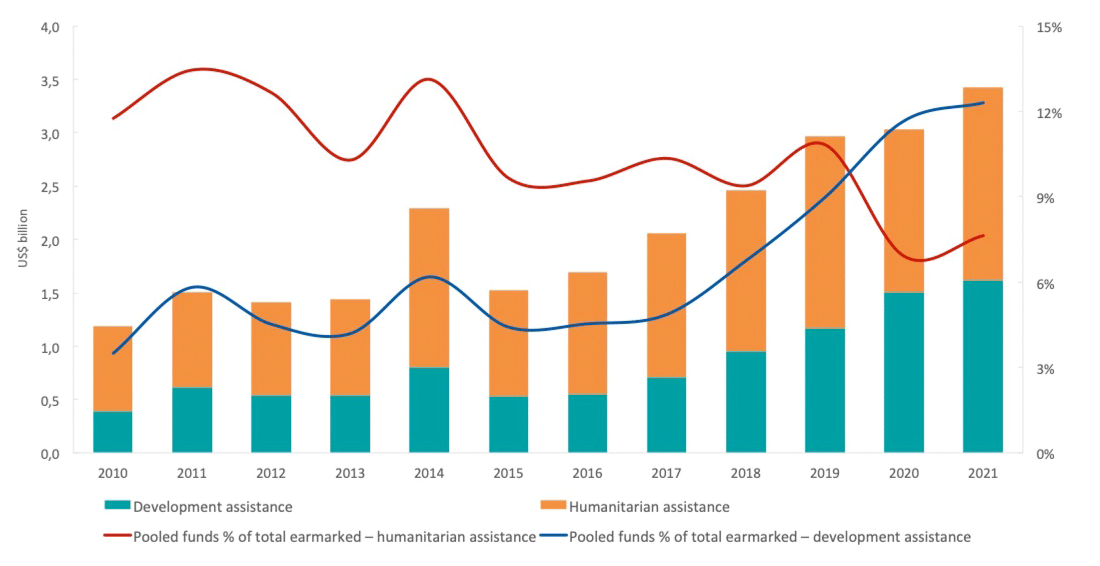Here is a sneak preview of data with a focus on UN pooled funds from the upcoming annual Financing the UN Development System report to be published in September. This information is released this week as Member States and United Nations representatives gather in New York for the annual Operational Activities for Development Segment organised by ECOSCOC. The 2023 theme is ‘Guiding United Nations development system’s support in response to interlinked crises and to accelerate progress towards the Sustainable Development Goals’.
UN inter-agency pooled funds are at the heart of UN reform and joint action. In recent years, these funds have become increasingly important in responding to multiple crises and providing holistic, integrated approaches to tackle global issues. UN pooled funds are a flexible type of earmarking that allows for multistakeholder collaboration and, thus, supports the implementation of national development plans.
A trajectory of growth
Totalling US$ 3.4 billion in 2021, contributions to inter-agency pooled funds have more than doubled since 2010. The contributions to development-related pooled funds have increased fourfold during the same time period. This growth is largely attributed to the introduction of the SDGs in 2015 and the ambition formulated between Member States and the UN in the Funding Compact in 2019.
Inter-agency pooled funds received 12.3% of earmarked development funding in 2021, with 22 countries surpassing the Funding Compact target of channelling 10% or more of their contributions through pooled funds.
Contributions to inter-agency pooled funds 2010-2021 (US$ billion)
However, the funding is still highly concentrated in quantitative terms with a majority of UN inter-agency pooled funds provided by a small, consistent group of contributors. The top 10 countries, which include the United Kingdom and Sweden, provide 86% of total funding. Germany was the principal contributor in 2021, increasing their investments by 74% and, together with Norway, also largest contributors to the climate and environment funds.
Simultaneously a process of widening the Member State support to UN pooled funds with 67 national governments contributing to UN inter-agency pooled funds in 2015 increasing to 78 in 2021. This surge is a testament to the commitment of many nations to support the global organisation’s efforts to tackle the world’s most pressing challenges. Among the new contributors, many non-traditional Member States are now actively investing in UN pooled funds showing solidarity and gaining value in being part of multi-stakeholder coalitions.
The UN Multi-Partner Trust Fund (MPTF) Office is the sole UN entity dedicated to design and implement multi-stakeholder pooled financing instruments. In 2021, the MPTFO supported 54% of all inter-agency pooled funds and 80% of funds with a climate, peace or development focus.
Afghanistan was the top country receiving UN inter-agency pooled funds, mainly as humanitarian, rural entrepreneurship, investment, and trade support. In 2021, 57 countries received 10% or more in earmarked development-related funds through flexible pooled funds, a rise from 28 in 2018 and 40 in 2019 respectively.
Quality matters
The UN and Member States have identified a set of quality management features to enhance the efficiency and effectiveness of inter-agency pooled fund activities. The UN development system has made noteworthy progress in developing common management features across inter-agency pooled funds, with 73% of development-related inter-agency pooled funds having implemented these features in 2021.
The trends in terms of deposits and contributions to UN inter-agency pooled funds is a positive story of growth and diversification. But there is still the possibility to extend the ambition and increase the use of pooled funds further.
Releasing new UN pooled funding data
The three additional data visualisations will provide information for partners to better understand the trends and how the pattern in UN pooled funding investment changes according to context.
Stay tuned for more information, analysis and data to be released in the 2023 edition of the UNDS Financing Report in September.
